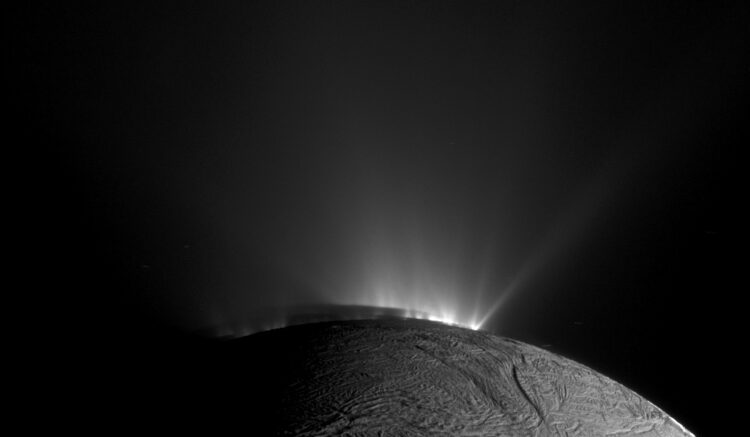Science
New Organic Compounds Discovered on Saturn’s Moon Enceladus

A recent analysis of data from the Cassini space probe has revealed new organic compounds in the icy jets of Enceladus, one of Saturn’s moons, bolstering the case for its potential to support life. The findings, published on October 1, 2023, in Nature Astronomy, indicate that these compounds likely originated from the moon’s subsurface ocean, providing compelling evidence for its habitability.
The Cassini space probe, which concluded its mission in 2017 with a dramatic descent into Saturn, continues to enhance our understanding of the Saturnian system. An international team of researchers, led by Fabian Klenner from the University of Washington, conducted a detailed analysis of data collected during a close flyby of Enceladus’ plume, which emits jets of icy water and gas from its south pole.
“We found a rich organic inventory in Enceladus’ plume,” Klenner stated. “Having clear evidence of a variety of organic compounds from inside an extraterrestrial water world is incredible and further strengthens Enceladus’ potential for habitability. It appears that Enceladus has all the ingredients for life as we know it.”
During its mission, Cassini performed numerous flybys of Enceladus, resolving significant mysteries about the moon and its surroundings. It was instrumental in establishing the existence of a vast, salty ocean beneath a thick layer of ice, which covers the moon up to 30 kilometers (approximately 19 miles) thick. The probe identified fissures in the moon’s icy crust, known as the South Polar Terrain, from which vast quantities of icy water are expelled into space. This material contributes to Saturn’s faint but extensive E ring.
Previously, data from Cassini’s Cosmic Dust Analyzer (CDA) helped identify organic materials and other essential building blocks for life within the E ring. Furthermore, evidence of hydrothermal activity deep within Enceladus has been suggested.
“We suspect that so-called hydrothermal fields exist there—these are vents at the bottom of the ocean from which hot water rises,” explained Nozair Khawaja, the lead author and a research group leader at Freie Universität Berlin. “There is evidence that life on Earth originated in such fields.”
The latest findings arise from data collected during a close flyby, which allowed researchers to analyze material that had just recently emerged from the moon. “The high-speed flyby of Enceladus enabled us to identify new compounds that were not found in the E ring data, most notably esters, alkenes, and ether compounds,” Klenner noted. “Notably, esters and ethers can be part of lipids, and lipids are key to life as we know it.”
The success of the Cassini mission has inspired significant investment in future explorations of the outer solar system. Currently, NASA’s Europa Clipper probe is en route to Jupiter to investigate its moon, Europa, another promising candidate in the search for extraterrestrial life.
In addition to the exciting discoveries, researchers believe there is still more to uncover from the extensive data gathered by the Cassini mission. Klenner expressed enthusiasm about the remaining CDA data that has yet to be analyzed, stating, “It’s phenomenal to continue learning from the Cassini mission. Much of the CDA data still isn’t analyzed, and I’m so excited about what it may reveal next.”
The study included contributions from a diverse team of researchers, including Frank Postberg, Thomas R. O’Sullivan, Maryse Napoleoni, Jon Hillier, and Lucía Hortal Sánchez, all from the Free University of Berlin, as well as Sascha Kempf from the University of Colorado, Boulder, and several collaborators from Japan and Germany. This research was supported by the European Research Council, the German Aerospace Center, the state of Berlin, and NASA.
For further inquiries, Klenner can be reached at [email protected].
-

 Technology5 months ago
Technology5 months agoDiscover the Top 10 Calorie Counting Apps of 2025
-

 Health3 months ago
Health3 months agoBella Hadid Shares Health Update After Treatment for Lyme Disease
-

 Health3 months ago
Health3 months agoErin Bates Shares Recovery Update Following Sepsis Complications
-

 Technology4 months ago
Technology4 months agoDiscover How to Reverse Image Search Using ChatGPT Effortlessly
-

 Technology1 month ago
Technology1 month agoDiscover 2025’s Top GPUs for Exceptional 4K Gaming Performance
-

 Technology3 months ago
Technology3 months agoElectric Moto Influencer Surronster Arrested in Tijuana
-

 Technology5 months ago
Technology5 months agoMeta Initiates $60B AI Data Center Expansion, Starting in Ohio
-

 Technology5 months ago
Technology5 months agoRecovering a Suspended TikTok Account: A Step-by-Step Guide
-

 Health5 months ago
Health5 months agoTested: Rab Firewall Mountain Jacket Survives Harsh Conditions
-

 Lifestyle5 months ago
Lifestyle5 months agoBelton Family Reunites After Daughter Survives Hill Country Floods
-

 Health3 months ago
Health3 months agoAnalysts Project Stronger Growth for Apple’s iPhone 17 Lineup
-

 Technology4 months ago
Technology4 months agoHarmonic Launches AI Chatbot App to Transform Mathematical Reasoning





















